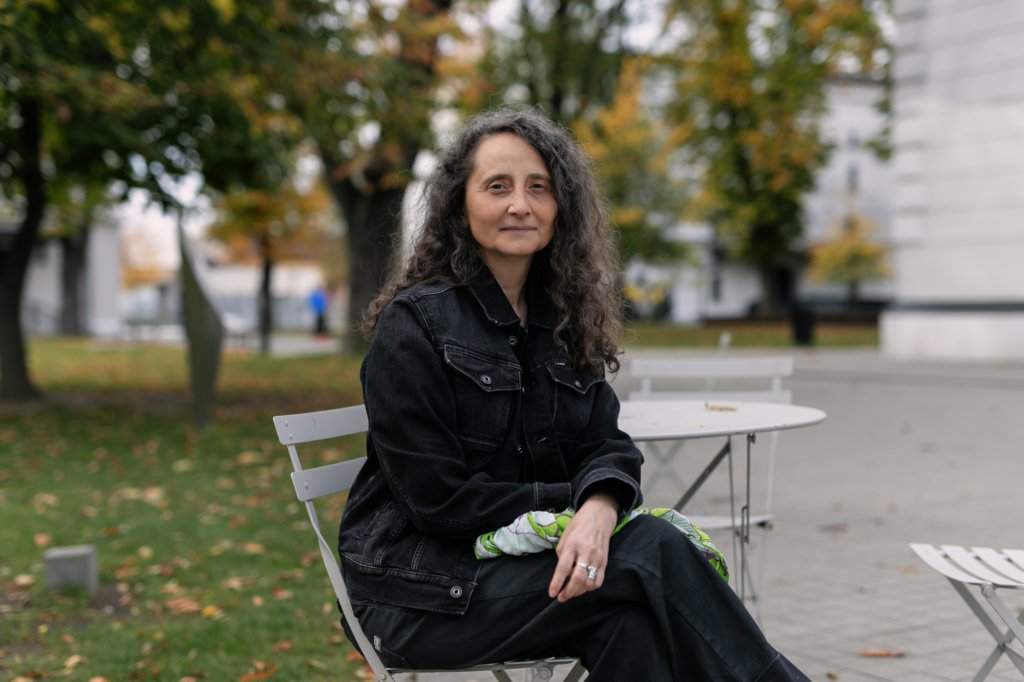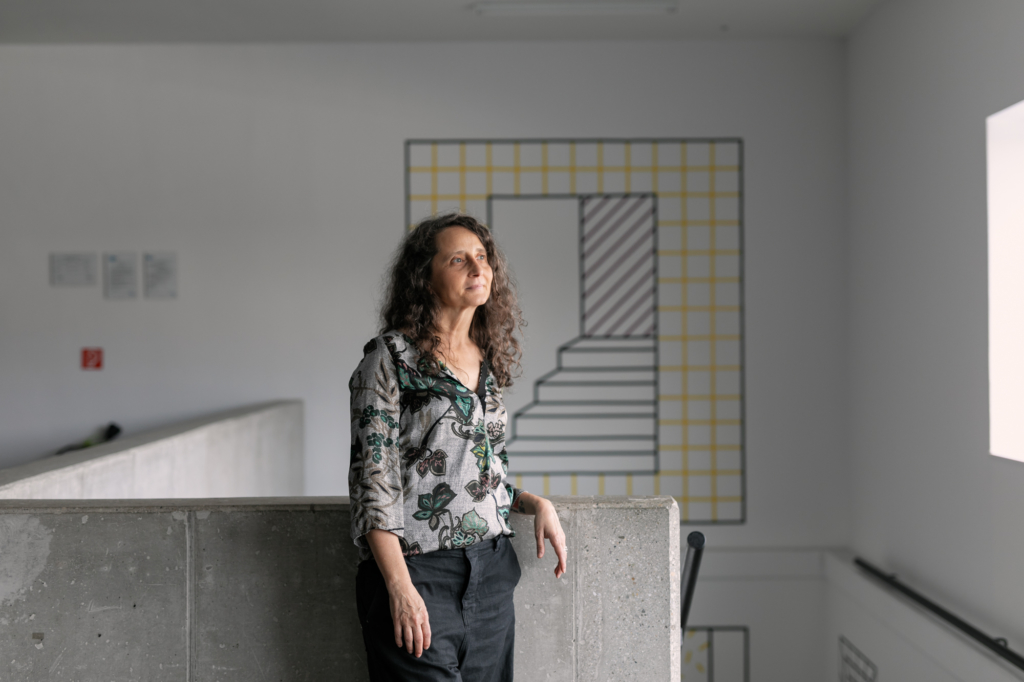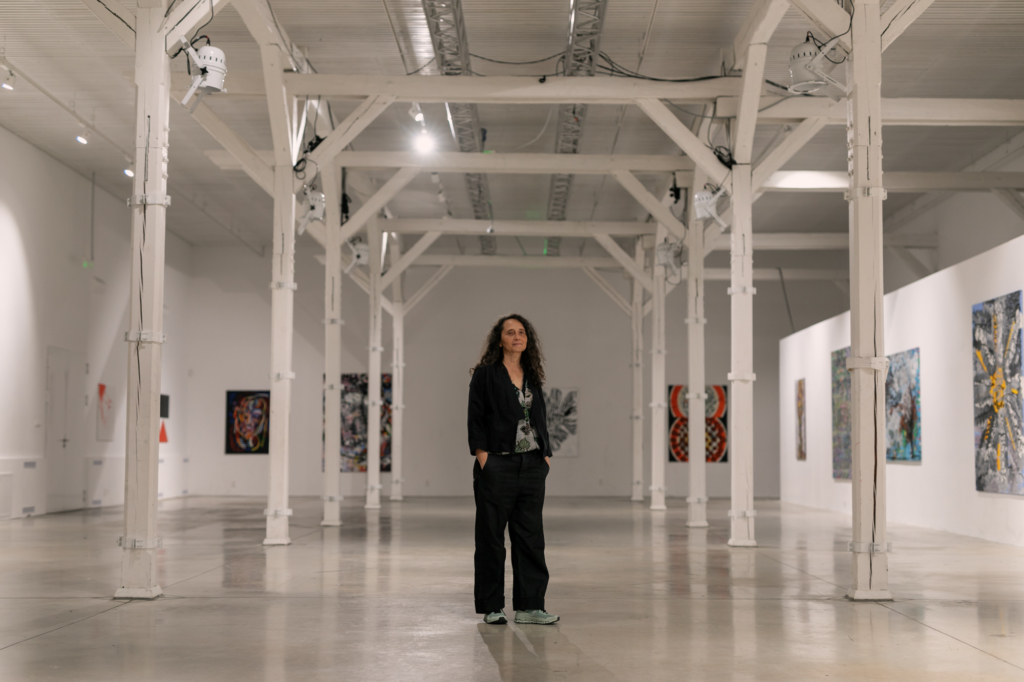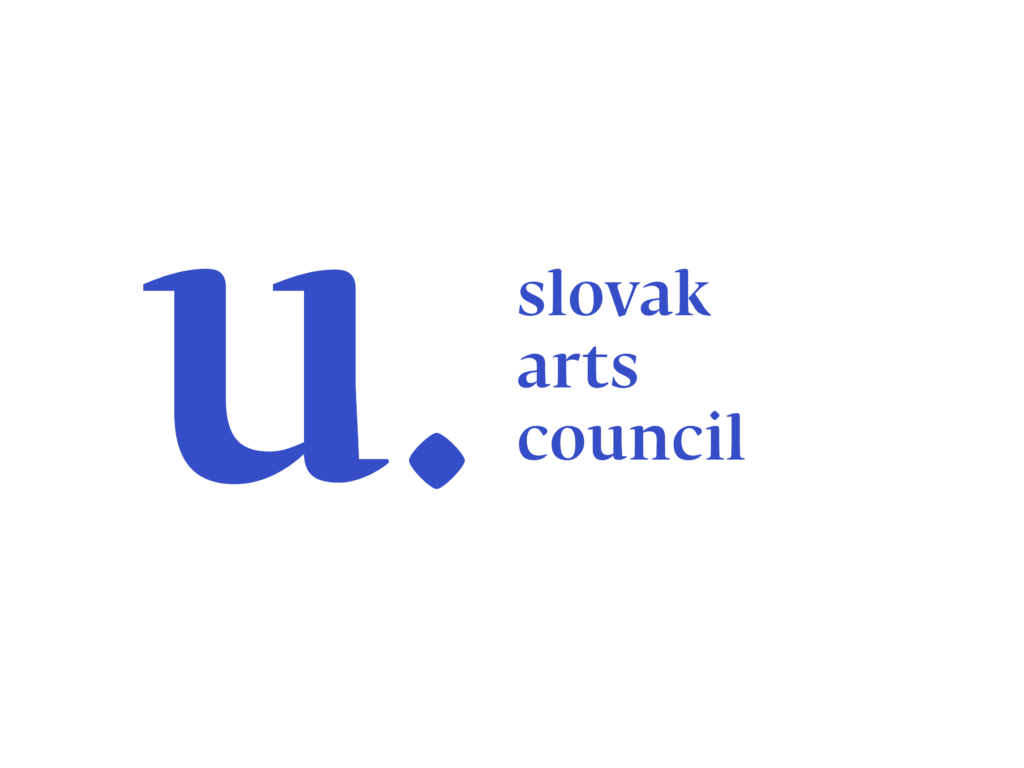Katarína Živanovič: Creativity should be part of identity
Her professional resume is very rich. She has worked in the field of cultural management for over two decades. She came to Košice in 2016, before that she worked as the director of the REX Cultural Centre in Belgrade, as the executive director of the Museum of the History of Yugoslavia and as the head of the Department of Culture in Belgrade. In Košice, she worked as the General Manager at the cultural centre Tabačka. Currently, she is managing the development of a creative cultural centre in Nitra.
Your work in Slovakia is connected with Košice. What was your first impression like?
I came to Slovakia for work. I am always most impacted by the energy of the people I meet, and that’s how I remember those places. I remember the energy of the people I met in Tabačka, the openness and the willingness. I was happy that they accepted me into the team even though I was a person they didn’t know before. But I have been lucky, similar things happened also in Nitra or Prague.
How did it come about that you started working in Tabačka?
Shortly before coming to Slovakia I finished my full-time job as the head of the cultural department in Belgrade and at that time I was only working on my PhD studies. I finished my PhD degree while working in Tabačka. The cultural centre was already running at that time, and my friends Paul Bogen and Sandy Fitzgerald were in contact with several people through the CIKE project. I had known Sandy and Paul for many years. We had met and worked together in the Trans Europe Halles (TEH, www.teh.net), a network of independent cultural centres, where I was also a member of the TEH Executive Committee. Their proposal for the future of Tabačka – the Escalator process – included the search for a new director. They were of the opinion that Tabačka should have a director to take charge of the whole process of expansion. They recommended me for that position, and so I received a call for a job interview. That was in 2015
At that time, Tabačka was a challenge not only in the cultural context of Košice, but in the whole of Slovakia. What were your expectations from the project and how did you see your place in this project?
When I get involved with a project, my expectations are that I will contribute as much as possible to the whole process. I see myself as a person who is doing a service, working for the community. So what was my contribution? Straight off the bat, it was research. I asked the people at Tabačka to give me the contact details of 10 people who are sceptical of Tabačka and 10 people who support Tabačka. According to the results, I prepared a proposal for the Board of Directors of Tabačka with various steps to be taken in the management of the centre. At that point, as the Board and I agreed, the expectations of the community became also my expectations. Our first steps were to professionalise the team, to have transparency and a clear overview of funding, a strategy for developing dramaturgy, and to develop multiple funding sources. We also looked at how to set up administrative processes, communication with the public. The whole process was built in such a way that it factored in not only the square meters of Tabačka, but also the heart of the new centre, which we gradually discovered. It’s great that we had the opportunity to conduct the process as open and flexible, and to perceive and reflect the demands of the community, to be open to the ideas of the dramaturgs. We knew that if we kept the process open, the heart of the building as well as the heart of the community would emerge and resonate with the hearts of the people who go there every day
Tabačka was conceived from the beginning as an alternative cultural space. In fact, we can say it’s a post-industrial space…
It’s an independent cultural centre that was not founded by the city, the state or the county. It is simply an initiative from below. It was built by leaders who not only had the idea, but also the energy to dedicate themselves to the difficult process of fighting for such an idea, and the result is a space that is relevant not only for Košice, but for the whole of Slovakia. I can say that it is a space that is also known outside of Slovakia. Whether it’s ‘alternative’ or not, that depends on how the word is used. We have tried to create a program that would not be aimed at just a small group of people and to gradually add new activities that would be encouraging and appealing to the wider community. And whether it is post-industrial? Yes, for a very long time there has been a trend in Europe for former industrial buildings to be used for arts and culture.
It is simply an initiative from below. It was built by leaders who not only had the idea, but also the energy to dedicate themselves to the difficult process of fighting for such an idea, and the result is a space that is relevant not only for Košice, but for the whole of Slovakia.
Katarina Živanović

The Košice Self-Governing Region has decided to support the creative economy. How has this fact influenced the functioning of Tabačka? Is it a natural process when public administration or local government enters into the creation of such creative centres while maintaining their independence?
There are different models. It is not common for independent centres to be supported by those who make development strategies and are active politicians at the same time. It is a difficult process that does not yield quick results, nor is it cheap. But it is, without question, a process that makes a long-term contribution to community development.
In the case of Tabačka, the owner of the building is the Košice Self-Governing Region, and from the beginning there was a contract that defined our relationship. Yes, a contract is just a piece of paper, so there was also a need for a great deal of flexibility on both sides in order to be able to implement the project. I am not a politician, but surely some kind of initiative, a fund that would support such activities in the long term, would have been appropriate. Maybe it is time to start thinking about the fact that independent organisations in the cultural and creative industries – that is, spaces for art, culture, creativity – are an asset to society. They deserve the support they need for stability. The Slovak Arts Council has made a lot of progress in that direction, but there is still a lot of room for such initiatives.
Tabačka itself has a very challenging funding model. When I was there, over 80 percent of our income was from our own resources. It’s a lot and it’s not quite typical for these types of projects. This model generates a lot of pressure and uncertainty for the team and, as a result, burn-out is often a problem for team members.
How was Tabačka perceived by the public and the artists or creative individuals who came there?
This perception is a process. It changes organically. The organisation changes, the programme evolves, the society changes. The relationship to Tabačka is also changing, both of those who use the space and of the visitors. It is always the case that there is a great interest when something new begins. When something new is offered, a new experience, people want to go there. Then the most challenging task for the manager is to sustain the interest and keep it going in a way that is meaningful both for those who started the initiative, but also for those who need this type of space.
I often used to hear when I was doing my research that Tabačka was supposed to fulfil what was expected of the K13 space and never happened. I had to deal with that information somehow because Tabačka could never replace K13, if only because the basic ideas and purpose of the two spaces were not the same. So Tabačka had to find its own way, while keeping in mind what kind of environment it was operating in, what the community’s expectations were, what the general habits were, and so on. Let’s say that what is fundamental for me is the people who regularly use Tabačka as a space to work, to create, to present the results of their own creativity. Tabačka has a co-working space, music rehearsal rooms, studios. In addition to spaces for public programs, both the Great Hall and the Black Box are used for the development of artworks. In Tabačka there is also a cinema, Fabricafe, bistro and a bar. The most recent project is called Tablab. Quite a few people go to Tabačka every day – some for work and some want to try something new. That’s why it was important that those who went there, or go there every day, are open and tolerant.
The building is not perfect and there has always been something that needed to be changed, reorganised. For example, one summer the HUB had to move to the cinema because it was very hot in the HUB area and we didn’t have the means to deal with it because negotiations with the municipality were not successful. Next, we had the Black Box, which was initially intended for one of our partners, Divadlo na Peróne. But fortunately Divadlo na Peróne quickly grew and suddenly needed the Great Hall and not the Black Box, which required a lot of flexibility. And when the Black Box was vacant, people found out about the space and came and brought in a new programme even though we weren’t promoting it.
It’s always been interesting to compare these things. We started with the cinema, and we received grant funding to buy projectors. And then every month it was a challenge for us to design the programme in a way that was interesting to people. We worked with a dramaturge who then set up his own project – Úsmev Cinema. The dynamics are interesting because we don’t fight amongst ourselves. Úsmev Cinema, as far as I know, is currently preparing a programme also for the cinema of Tabačka.
I don’t want to claim that everything is rosy, that everything is great. It isn’t. These are processes between people where everything is not always ideal, but I have the feeling that Tabačka, Úsmev Cinema, CIKE and other organisations and their people like the city of Košice and want to live there. For me it is essential that the energy and creativity stays there and they try to change and improve the environment.
I think it was very important that various foreign artists and creative individuals started coming to Košice and Tabačka and influenced the space. How were they received?
From the beginning, Tabačka was thought of as a cultural centre with an international programme. But it wasn’t reflected in the budget. So we started to work on it systematically and through a theatre, music and exhibition programmes we managed to bring foreign artists to Slovakia. We also added new content, such as the interconnection of visual arts, science and technology. My experience is that artists from abroad are open-minded people who want to learn about new cultures. Another important detail is that within the Tabačka building there is also a hostel and that we collaborated with CIKE, which has its own residency program. This also shows that Tabačka cannot be seen as a separate phenomenon. It is part of the dynamic overall development of the artistic and cultural scene in Košice, and foreign visitors are also part of it. If they only came to Tabačka, it wouldn’t help the city. Even though they may be happy because they find everything necessary there, it is in a way a microcosm. It is important that they get involved in other initiatives in the city, because Košice is more than just Tabačka. It is a living community.
After you left Košice, you worked in Prague and then you moved to Nitra. Nitra is a different cultural space. Do you think we are ready to think about the position of creative centres in public space? What is often forgotten when establishing a new centre?
I will say half-jokingly that there are never enough storerooms in terms of space in square metres. They are never enough. Yes, Nitra is a different environment. It is a project of the city, which has received funding from the EU. Therefore, there are two kinds of rules to follow when building the centre: the rules of the city and those of the EU. I am an employee of the Municipality of Nitra and I am grateful for this new experience, where I have the opportunity to look at the process of building infrastructures for the development of culture and creative industries from the perspective of the founding entity. This is a different experience for me compared to the past. But what is the same is that I have managed to put together a team of people who are very motivated, who are fighting for this project. These are people who don’t ask what time it is, if it’s the end of the working day. Quite simply – they care about the project and without people like that, no project will move forward. After all, the whole project aimed at establishing creative centres all over Slovakia is very ambitious.
I am very grateful to be in Slovakia at a time when such things are happening. I was there when Tabačka was being built, I followed the development of Nová Cvernovka and the Stanica Žilina-Záriečie centre, the creation of the very inspiring ANTÉNA network, which brings together independent cultural centres in Slovakia. But I will say again, it’s not rosy, it’s not easy. I am trying my best to be part of the process, to make a contribution. And there is always room for improvement in the care of these initiatives and the recognition of their contribution to the community.
Can the transition of culture into post-industrial spaces also be seen as a form of decolonisation of the arts? That is, is it a way to eliminate inequalities in culture, to improve access for minority artists and minority genres to the opportunities to create and get engaged?
What you are talking about is the ideal situation. I was in Partizánske and I saw the preparations of a project in which one part of the former Baťa factory will be used as a cultural and community centre. The people who are entering these projects are ready for inclusion. I must repeat that space as such means nothing, but the people who enter into such projects are the foundation. There are enough of them in Slovakia and they come from different generations. With these people, it might be possible to find a new purpose for former industrial spaces, even though those centres will never be exactly the same. The centre in Partizánske will never be like the Creative Centre in Nitra. In Nitra we are renovating 4 buildings of a former barracks, but this space will be very different from the one in Ljubljana in Slovenia, for example, or in K13 in Košice. No two renovations of former barracks are the same, because they are always the result of an initiative that originated in a particular community. We are currently learning to perceive the needs of communities, to ask what they need. Sometimes small groups of people are interested in the initiative – those who come up with the idea and those who discover it. But it’s not about numbers, it’s about persistence. The process of re-appropriating these spaces is never quick or easy. The ultimate result is what you described in your question. That should be the main benefit: better accessibility to culture and the arts, fostering creativity as a part of everyday life on the basis of tolerance, inclusion, accessibility – both spatially and conceptually.

In Slovakia, the cultural context is different from Serbia and maybe also from other cultures you have worked in. You yourself said in an interview that you like the way Slovaks perceive culture as a leisure activity, a pastime…
I first experienced that in Košice. Absolutely brilliant. Although I would add, not necessarily as a pastime, but as a hobby, as a valuable way to spend their free time.
How do you perceive the culture in our area now, with some hindsight?
My perception is that culture is increasingly contributing to the development of communities, to the development of the whole society in Slovakia. One of the reasons is the emergence of these independent creative cultural centres, and now there’s a new generation of institutionalised cultural centres, and that’s a huge development. It seems that society is slowly but surely coming to terms with the benefits of a broadly understood culture, art and creative industries to the development of society. But these are pioneering steps and a daily struggle. It’s like being human – when it comes to the building of a cultural infrastructure, we’re just going through puberty. But I see continuity here, it hasn’t stopped since I’ve been here. On the contrary, it’s a continuous evolution.
Your resume is very rich. In those twenty-five years or so, you have had the opportunity to influence the development of culture in three countries: Serbia, Slovakia and the Czech Republic. When you look back on this period, were the changes that have taken place sufficient to support the challenges required in a global sense – in relation to the preservation of life, to the digital age, to the need to create an economy for the people, that is, within the intentions of the EU’s strategic cultural framework?
It is not the same everywhere. Some people need more time and perhaps do not have the capacity or the money. I am very critical about this and I always expect that we can do more. At a certain time in my life I was very unhappy that we were not giving more, that those of us working in the cultural and creative industries were not the same type of pioneers as the generation that produced my role models. I expected that our creativity, our way of perceiving life and the universe in general, is what should be more visible and form some kind of morality as well. I felt that somehow we didn’t get it right at a certain time. I’m critical and I think we need to be more active in influencing social life. I am afraid that it is not enough that we have an artistic and cultural programme. Yes, that is part of our work, but it turns out that we also need to be more active in influencing what visions are formulated in politics and what decisions are taken. The problem I see is that people in culture work a lot and we do not have enough time for these things. In the current environment we don’t ask how much money there is available for a specific project, we just work. The people I work with now, the third or fourth generation, seem to have that attitude as well and they say they have little time to be involved in society outside of their own work.
We also need to change the way we look at our profession!
‘We’ feel that we should be happy because we are doing the things we love and others don’t have that luxury. Therefore, the question of whether or not we can make ends meet is irrelevant to us. We have to change that view. And it has to be us who changes it. We can’t expect someone from outside to come in and say ‘we’ll give you more money because you should receive decent pay’. Or ‘we will allocate more money to culture’. We have to fight for those positions in society, but not all of us have the energy and time to do that after work. That’s why not enough cultural workers are publicly known.
‘We’ feel that we should be happy because we are doing the things we love and others don’t have that luxury. Therefore, the question of whether or not we can make ends meet is irrelevant to us. We have to change that view.
Katarina Živanović

I like to ask when someone comes to Košice who they associate Košice with, which individual face. Because Košice is people. And among them are those who work in the field of culture and art. These are our brands. For example, in the context of building a creative centre in Nitra, we have a long-term vision to make artists feel at home in Nitra and to make Nitra citizens perceive creativity as part of their identity. So we all need that connection and we are proud that there are artists among us. It will certainly help us that there are new generations emerging who are motivated for this type of work, who see it as dignified, and who will also want to earn a decent wage. It is all about what is seen as an asset by our society and what is not.
Is it necessary to explain over and over again what culture is about?
When I was younger, I used to go to various meetings in Europe and they all started with thinking about what culture is and why we need it. I was young and I was quite angry about it. Now that I am older, I understand it – even today, in 2022, we need to explain the purpose of culture. A doctor does not have to explain what his purpose is, neither does a chef, but even today we are looking for words to explain to society what we are here for. We have to point out examples of our work and attitudes in society. Formulating our purpose is our daily challenge. We need to articulate the narrative that our real purpose is the contribution we make to society.
Invisible Mag is supported using public funding by Slovak Arts Council. The Slovak Arts Council is the main partner of the project.

